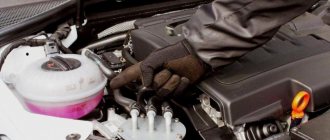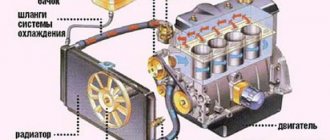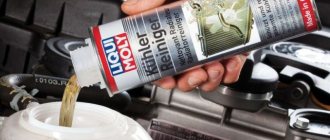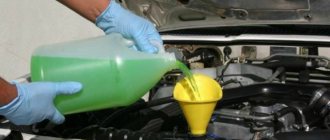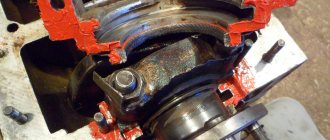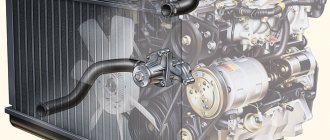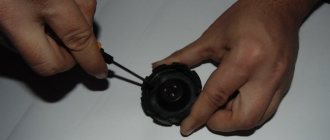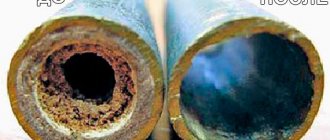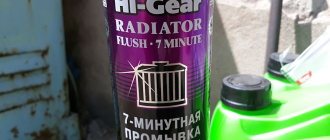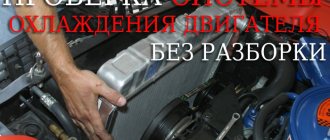The Niva SUV, in all modifications, is very popular in Russian spaces. This is due to good maintainability, low price and excellent maneuverability. To ensure reliable operation, you should undergo all maintenance on time, in particular, replace the coolant.
The liquid system with forced circulation of the VAZ 21214 car is designed for effective heat removal. It fully copes with its task, you just need to keep it in good condition.
Problem
Imagine the situation: a person buys a used bib, all the cooling pipes are oak, the clamps are rusty, the whole system is “candied.” And “nuclear” washing is poured there. As it should be, it works very well and removes “whole pieces” of dirt from the walls. But these “blood clots” clog the capillaries of the main radiator and the heater radiator. After which you either need to remove them and try to blow them out with high pressure or take them to the trash heap. “Soft” rinses work on the principle of dissolution. Dirt and chemical film from old antifreeze dissolves (rather than falling off in pieces) and drains from the system.
Consequences of untimely replacement
Briefly about the consequences of untimely replacement of refrigerant:
- Deposits will form in the cooling system. Loss of refrigerant properties will lead to the appearance of sediment, which will primarily clog the expansion tank and radiator unit. Because of this, antifreeze will not be able to circulate effectively through the cooling system lines.
- The heater will not work efficiently. The performance of the stove will be impaired as a result of obstruction of the pipes due to the formation of deposits in them. This problem usually occurs during the cold season.
- The car engine will overheat. If replacement intervals are violated, the life of the refrigerant will expire, causing it to lose its properties. Because of this, antifreeze will not be able to effectively cool the engine, which will ultimately cause overheating. Constantly driving a Daewoo Nexia with an overheated engine will lead to the destruction of the inter-ring partitions on the internal combustion engine pistons. Because of this, the plane on the blocks where the cylinder head is installed will be curved. Also, constant overheating will lead to rapid failure of the seals. They will begin to ooze and leak grease, so you will have to look for the oil leak.
Chemistry
There are more than two dozen cooling system flushes, maybe more, but I’m talking about what I use myself and not only in cars of the Niva family. In this case, the product of the company. I've probably done about 50-70 cooling system flushes myself with this product at this point. Why did I like him? According to two indicators. The first is humane pricing and the opportunity to work directly with a Russian manufacturer. The second is its chemical characteristics. If no special explanation is needed for the first point, then I will dwell separately on the second.
Cooling flushing or engine flushing can be “soft” or “nuclear”. This is my definition, and it does not appear in the literature)))) As I said above, “nuclear” washing can clean everything to a shine, but clog both radiators, “soft” - may be less effective, but more humane in relation to the whole system.
A little from the piggy bank of the “old school of motorists.” For a long time I used citric acid to flush the system. It works not bad, but compared to the same laurel it is less effective. On the “motorists” forum there are masters who recommend and use concentrates for cleaning kettles and washing machines. And they even talk about a good result. But for some reason it seems to me that scale in a kettle and a chemical film from antifreeze are not the same thing.
Simple cleaning products
Almost every owner has distilled water available. It is quite suitable for cleaning the system from simple contaminants. The water washing process is carried out in the following order:
These steps must be repeated until the water is clear when drained. This method will not help get rid of contaminants such as scale or rust.
You can also use lactic acid, caustic soda or vinegar to flush the cooling system. These products need to be mixed with distilled water, and then the same steps described above are performed. There should not be too much acid, otherwise such a solution can damage the rubber and plastic elements of the car. At the end of the procedure, you need to fill in clean distilled water, which is necessary to clean the system of residual solution.
Notes and recommendations
After draining the liquid again, it is imperative to wait for the block to cool down to 40-50 degrees, and under no circumstances pour cold liquids into a hot block (especially in winter). During each filling process, check whether hot air is coming from the stove and whether an air lock has formed. Try not to breathe too much fumes from hot antifreeze. Rubber gloves are required, glasses are advisable. Every day I inhale the divine smell of gasoline and oils and do not feel any discomfort. But my body reacts much worse to hot antifreeze vapors. Headache and nausea are present, and I know for sure that I’m not pregnant))
Pre-check the thermostat on the Niva Chevrolet
Of course, no one will remove the thermostat for fun. Just for the preliminary check, we will carry out several simple operations in order to make sure that it is not working or, conversely, that it is working properly.
To do this, start the cold engine and touch the lower radiator pipe. It should be cold.
This means that the thermostat is closed and the coolant flows in a small circle: expansion tank, pump, thermostat valve, cylinder head and cylinder block, throttle heating system (in an injection engine), heater radiator.
As soon as the engine warms up to operating temperature (82-85 degrees), as can be judged by the temperature gauge on the dashboard, the lower radiator hose should begin to warm up.
This indicates that the thermostat valve has opened and antifreeze flows in a large circle through the radiator of the cooling system. Fast and easy. If the hose begins to warm up when the engine is cold or does not begin to warm up when the engine is hot, the thermostat must be checked in more detail or replaced. Let's start with replacement.
5.4. Flushing the cooling system
| GENERAL INFORMATION |
If the coolant was replaced irregularly or the concentration of antifreeze in the coolant decreased, then the efficiency of the cooling system will be reduced by due to the fact that the permeability of the channels and hoses of the cooling system will decrease due to the formation of rust, carbon deposits or other deposits on their walls . In this case, the cooling system must be flushed.
The radiator must be flushed regardless of the engine.
To flush the radiator, drain the coolant from the cooling system, then disconnect the hoses from the base and upper radiator reservoir. Insert a garden hose into the top hose of the radiator and run water through the radiator until water comes out clean from the hose at the base of the radiator. If the radiator is very dirty, wash it using a special cleaner. You can also reverse flush the radiator by inserting a garden hose into the lower radiator hose.
Carry out engine flushing as follows.
Initially, antifreeze is poured into the Chevrolet Niva cooling system from the factory, the service life of which is extremely short. And also the composition and additives used are much inferior in quality to modern liquids made on a carboxylate or polypropylene glycol base. Therefore, many car enthusiasts prefer to replace it with antifreeze, which better protects the cooling system, when replacing it for the first time.
When and why to flush
Solving this problem does not require special skills and knowledge, so you can flush the cooling system yourself. It is recommended to do this more often, but even if you perform cleaning once a year, you can achieve a positive effect.
Flushing allows you to avoid the occurrence of various malfunctions associated with the cooling system. The need for this procedure often arises due to the use of low-quality or expired antifreeze, which negatively affects the cooling unit of the car.
You can clean the cooling system less frequently if you adhere to the following rules for using antifreeze:
Stages of replacing Chevrolet Niva coolant
When switching from antifreeze to antifreeze, it is necessary to flush the cooling system. This is done so that the new liquid does not lose its properties when mixed. Also, due to the different chemical composition, a precipitate or flakes may form. Therefore, the correct procedure between draining and filling should include a flushing step.
This model is quite popular, so many people know it under other names:
- Chevrolet Niva;
- Chevy Niva;
- Shniva;
- VAZ-21236.
We will consider the instructions for replacing the coolant using the example of a 1.7-liter gasoline engine. But there is one nuance: cars after the 2016 restyling have electronic control of the gas pedal.
Accordingly, there are no pipes for heating the throttle valve. Therefore, we will consider bleeding air on this modification. You can also familiarize yourself with the nuances of replacement on a regular Niva 4x4, the replacement on which we also described.
Coolant drain
To drain the antifreeze, you need to place the car on a flat surface, open the cap of the expansion tank and wait a little until the temperature drops below 60°C. For further convenience, remove the decorative plastic protection on top of the engine.
Further in the instructions we are recommended to turn the temperature regulator to maximum. But it is useless to do this. Since the temperature control in the Chevrolet Niva occurs by moving the air damper. And not by blocking the radiator as in old VAZs.
After the machine has cooled down a little, we begin the draining process itself:
- If you stand in front of the car, at the bottom right, there is a plastic valve on the radiator that closes the drain hole. We unscrew it to drain the antifreeze from the radiator (Fig. 1). When unscrewing, be careful not to lose the rubber O-ring.
In this way, we completely drained the old fluid, but in any case, a small part still remains in the system, distributed among the engine channels. Therefore, in order for the replacement to be high-quality, we proceed to flushing the system.
Flushing the cooling system
If the Chevrolet Niva cooling system is not clogged, but is simply undergoing a scheduled replacement, then we use ordinary distilled water for flushing. To do this, close the drain holes and pour distilled water into the expansion tank.
Then close the tank cap and start the engine. We warm it up until the thermostat opens to flush both circuits. Next, turn it off, wait for it to cool and drain the water. To achieve a good result, it is recommended to do this procedure 2-3 times.
If the car system is heavily contaminated, it is recommended to wash it with special chemical solutions. For these purposes, washes from well-known brands, such as LAVR or Hi Gear, are suitable. Recommendations, as well as instructions, are usually printed on the back of the container with the composition.
Filling without air pockets
To properly fill new antifreeze into a Chevrolet Niva, you need to perform a number of steps. After all, it depends on whether an air lock forms in the system or not. We will close the drain holes in stages, so for now we will leave them open:
- We begin to pour antifreeze into the expansion tank, as soon as it flows through the drain hole in the radiator, we put the wing plug in place.
- We continue the flood until it starts flowing from the hole in the block. After which we close it too. The drain bolt on the block must be clamped with a slight force, approximately 25-30 N•m, if you have a torque wrench.
- Now we need to bleed the air from the top of the radiator. To do this, we find a special plug, the location of which is shown in the photo (Fig. 3). We unscrew it a little, continue to pour antifreeze into the tank, as soon as it flows, screw the cap back into place.
The better to rinse
To flush the cooling system, a variety of solutions are used, using both professional auto chemicals and universal and even folk remedies. The simplest method is rinsing with distilled water: it removes simple contaminants. However, if flushing has not been performed for a long time or scale and rust are found in the drained antifreeze, using ordinary water will not help.
In this case, you will have to use other means that can remove heavy dirt. Folk remedies for cleaning the cooling system include :
Coca-Cola containing phosphoric acid may also be suitable for removing rust . Due to the excess carbon dioxide, Coca-Cola can only be used after the gases have come out of it. In addition, the excessive concentration of sugar still makes it not a particularly suitable remedy, since sugar itself can leave unwanted deposits.
Reference. Traditional methods of washing cannot be compared in their effectiveness with professional autochemical products.
The operating principle of professional auto chemical products is also based on the effect of an alkaline or acidic solution on the source of pollution. The range of specialized washing solutions is quite large, so you can divide them into separate groups:
The most popular products on the Russian market include the brands Lavr, Astrokhim, Liqui Moly, Hi-Gear, Gunk and others.
Replacement frequency, what antifreeze to fill
In the maintenance information for Niva Chevrolet, it is recommended to change antifreeze every 60,000 kilometers. But many car enthusiasts are not happy with the flooded antifreeze, which becomes unusable by 20 thousand. Dzerzhinsky antifreeze is usually filled from the factory, but there is also information about pouring red antifreeze.
When choosing coolant, it is better to use a concentrate rather than a finished product. Since it can be diluted in the required proportion, because after flushing there is still some distilled water left in the system.
A good choice would be Castrol Radicool SF concentrate; it is what dealers often recommend for use. If you choose ready-made antifreezes, then you should pay attention to the red AGA Z40. FELIX Carbox G12+ or Lukoil G12 Red with good reviews.
How much antifreeze is in the cooling system, volume table
| Model | Engine capacity | How many liters of antifreeze are in the system | Original liquid / analogues |
| Chevrolet Niva | gasoline 1.7 | 8.2 | Castrol Radicool SF |
| AGA Z40 | |||
| FELIX Carbox G12+ | |||
| Lukoil G12 Red |
Replacement instructions
The procedure for replacing the coolant is not complicated, so even a novice car enthusiast can perform it.
How much to pour?
Antifreeze in a car, according to the manufacturer’s recommendations, should be changed after 40 thousand kilometers or after two years of operation. In this case, it is necessary to constantly monitor the condition of the coolant and check its level. If it has darkened or become cinnamon in color, then it needs to be changed. If the level is below the required level, add water or antifreeze. Replacement may be required if the coolant poured into the car does not meet the density.
The required volume of liquid to be filled is 10 liters. It is advisable to fill with coolant specified in the owner's manual.
Coolant
What will you need?
To carry out the replacement, you will need an inspection hole, a lift or an overpass. The machine must be installed horizontally and secured so that it cannot roll during work. The front of the machine should be installed higher than the rear. The procedure is carried out only on a cold engine. To carry it out you need to prepare the following tools and materials:
- spanner set to “10”;
- pliers;
- screwdriver;
- funnel;
- container for draining waste liquid;
- new antifreeze;
- clean rag.
A watering can can be made from a plastic bottle by cutting it in half. A canister or plastic water bottle is suitable as a container.
Stages
Having installed the car on the inspection hole, they begin to replace the coolant.
- First, open and secure the hood.
- The next step is to unscrew the cap on the expansion tank. It is advisable to perform the procedure on a cold machine.
Expansion tank Niva Chevrolet
If this is not possible, then the coolant temperature should be no higher than 90 degrees. To avoid getting burned by steam or hot liquid, place a rag on the engine and around the neck of the expansion tank. The lid should be unscrewed carefully. First you need to unscrew it a little so that hot air comes out and release the tank from pressure, and then unscrew it completely.
- Now unscrew the plug on the drain hole and drain all the liquid. When the used antifreeze has drained, screw the plug back into place.
- To prevent the formation of air plugs in the cooling system, you need to disconnect the hose from the throttle body fitting. To do this, use a screwdriver or pliers to loosen the fastening on the clamp and move it back. Then disconnect the hose from the throttle assembly fitting.
- Before adding coolant, it should be prepared. There are ready-to-use liquids, mainly antifreeze. There are antifreezes that require dilution with distilled water; usually the proportion is 50/50, unless otherwise indicated in the instructions.
- Next, you can proceed to filling the cooling system.
Fill with antifreeze
Coolant is poured into the expansion tank. As soon as it begins to flow out of the throttle body nozzle, put the hose on the nozzle and tighten the hose clamp. Next, continue to fill the antifreeze solution to the maximum mark in the expansion tank.
When pouring the antifreeze solution, tighten the radiator hoses to prevent air pockets from forming. After the cooling system is filled, screw the cap on the expansion tank. Next, you need to start the engine and wait until the electric fan turns on. If this does not happen, you need to check what kind of air is coming from the heater. If it is warm, then the fan is faulty, if it is cold, the reason is the presence of air pockets formed in the system. To get rid of them, you need to open the cap on the radiator, start the engine, and after 5 minutes of operation, turn off the engine. Now close the radiator cap.
Removing the radiator cap
When the second cooling circuit opens, the coolant level will drop significantly. You must wait until the engine cools down. Next, check the fluid level again. On a cold engine it should be between maximum and minimum, on a hot engine it should be at maximum. If necessary, add to the required volume.
When several days have passed after the replacement, you need to check the fluid level and get rid of possible air pockets. The process of getting rid of air pockets is the same as when replacing antifreeze: remove the cap on the radiator, let the engine run for a few minutes, close the radiator. You should also pay attention to the color of the antifreeze, if it has changed: it has darkened, become reddish, most likely a fake has been filled in, in which case the coolant needs to be replaced.
How to choose antifreeze?
The creators of this car have already made sure that you don’t have to choose anything; all the necessary brands of coolers are described in detail in the additional instructions. All you need is to remember basic safety rules that will help you avoid harming yourself or your car.
We recommend: How to choose winter tires
Replacing antifreeze is a preventative action that should be carried out periodically not only in winter, but also in summer, periodically adding the necessary fluids so that the car always functions well.
Which company is better
“Behind the Wheel” tested coolants in November 2022. Test results
In the survey below we provide recommendations for choosing a coolant manufacturer. We share tips in the comments. Let us remind you that the process of replacing antifreeze on Lada cars is described in this article.
Antifreeze Niva, basic practical issues
Answer: AvtoTAZ poured blue-green antifreeze for a very long time. But since 2012, almost every car I've seen has been a red G12. But there are still batches of cars filled with antifreeze.
What can be added and what can be mixed?
Answer: G11 and G12 cannot be mixed. Translated into Russian, blue-green and red-orange cannot be mixed.
- How to competently switch to G12? If you simply drain G11 and fill in G12, there will be no benefit except wasted money. The result will only be obtained after a “chemical” cleaning of the cooling system.
- Why do you recommend replacing “blue” with “red”. And so everyone works well. True, I have already changed several thermostats.
Answer: According to German articles on cooling, one of the reasons for thermostat failure is precisely low-quality antifreeze. We are talking about the film that jams the thermostat valve.
“Red” antifreeze is filled in, but for some reason when the engine heats up, it expands very much (can be seen from the level in the expansion tank).
Answer: it was filled with low-grade body slurry. When heated, water increases in volume up to 8-10%, antifreeze within 1%.
Antifreeze Niva, concentrate or ready-made?
Answer: Now I supply ready-made antifreeze, but we have a large country, so in a number of regions antifreeze with a crystallization temperature of minus 40 and below is required. Then you need to order the concentrate and dilute it according to your operating conditions.
The next question follows from the previous one and it usually comes from Yakutsk, Irkutsk, the Yamal Peninsula and other “resort” places in our homeland. What are the ratios for greater frosts than minus 40?
Answer: I provide data from Neste documentation. 50% -50% (water-concentrate ratio) – pour point minus forty.
40% water - 60% conc. freezing threshold minus 50 degrees. 25% water - 75% conc.
the freezing threshold is minus 65-70 degrees. But don’t get carried away. The freezing threshold increases, but other characteristics worsen.
What antifreeze do you use and complete orders?
Answer: I prefer the products of the Elf-Total concern and the antifreeze of our northern neighbors, the Finns. Manufacturer: Neste. This is if we talk about applicability to the Niva and UAZ family.
Antifreeze Niva, how much do you need to replace?
Answer: There are about 8 liters of coolant in the system. It can be drained as much as possible if you park the car on a slope, with the left side at the bottom. When the plugs on the block and radiator are open, almost everything drains. The quantity in Niva and Shnivy is the same.
Sources
- https://chevniva.ru/obem-sistemy-ohlazhdeniya/
- https://avtonomnaya-gazifikaciya.ru/kalina/obem-ohlazhdayushchej-zhidkosti-niva.html
- https://7road.ru/drugoe/kak-slit-antifriz-s-nivy-shevrole.html
- https://sto-AvtoStroy.ru/dvigatel/zamena-tosola-na-antifriz-shevrole-niva.html
- https://AvtoSotka.ru/tyuning-i-remont/kak-promyt-sistemu-ohlazhdeniya-niva-shevrole-2.html
- https://prometey96.ru/obsluzhivanie/zamena-tosola-niva-shevrole.html
- https://nadouchest.ru/skolko-litrov-ohlazhdajushhej-zhidkosti-v-nive/
- https://avtozam.com/vaz/chevrolet-niva/protsess-zameny-ozh/
- https://kraniauto.ru/raznoe/kak-slit-tosol-s-shevi-niva.html
- https://fix-my-car.ru/texnicheskoe-obsluzhivanie/zamena-antifriza/chevrolet-niva-zamena-antifriza.html
- https://AlanSpb.ru/drugoe/promyvka-sistemy-ohlazhdeniya-shevrole-niva.html
- https://avto-prestig.ru/diagnostika-i-obsluzhivanie/skolko-litrov-antifriza-v-shevrole-niva.html
Recommendations for choosing for Chevy Niva
To determine which antifreeze is best to pour into your Chevrolet Niva, you need to know which one was filled from the factory, since each model has a lot of specific nuances. However, in most cases, the choice of coolant depends on the year of manufacture of the car:
- for older models that were produced before 2001-2002, class G12 fluid is suitable;
- for later models (from 2003 to 2010), G12+ antifreeze is suitable;
- for modern models (manufactured after 2010), it is recommended to purchase coolant category G12++.
Also, many people use the domestic mixture Antifreeze class TS-40 as antifreeze. Motorists often speak negatively about Antifreeze, but in its properties this liquid is practically no different from foreign antifreezes. To understand the absurdity of negative reviews, you need to remember that most Chevrolet Niva cars are filled with antifreeze at the factory.
The only major drawback of antifreeze is its shorter service life in comparison with G12 mixtures - in this the domestic cooler is really inferior to its foreign analogues. The recommended replacement frequency is 30 thousand km, and for some antifreezes the interval between replacements can be up to 200 thousand km.
To find out more information, watch the video in which an expert answers the question of what is better - antifreeze or antifreeze:
Signs of a damaged cylinder head gasket
In order to detect a malfunction in time and seek help to replace the gasket, you need to know the characteristic signs accompanying the breakdown. With internal burnout, the following may appear:
- white smoke from the muffler, one of the reasons for the appearance of which may be antifreeze entering the combustion chamber;
- foam on the level dipstick, indicating the formation of an emulsion from antifreeze in the oil system;
- By removing the radiator cap, you can see the characteristic oil stains on the surface of the coolant.
External burnout can be detected by the appearance of oil streams on the surface of the block. In all cases, you should contact a specialist as soon as possible to find out the exact reasons and, if necessary, replace the gasket.
Service Motors technicians provide quick and high-quality repairs to all vehicle components at reasonable prices, and details about the services provided can be found by contacting the company manager at the coordinates indicated on the page.
Fuel tank characteristics
The fuel tank of this model has almost sixty liters, or more precisely 58. On average, per hundred kilometers you have to spend 8-9 liters of AI-95, Premium-95 or AI-92 gasoline. Features of the fuel container:
- the tank is located directly under the rear seat;
- in the upper part there is a small hatch under which the fuel pump is installed;
- The sensor will help determine the level of fuel fluid and the amount of gasoline.
There are other Chevrolet Niva filling tanks, many of which are included in various systems.
